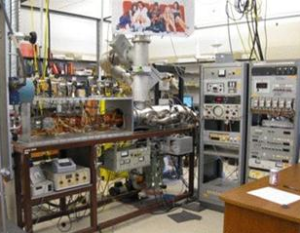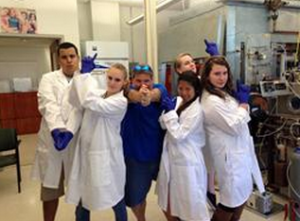I spent this week with professor JC Poutsma’s analytical chemistry lab, which stands at the exciting interface between chemical instrumentation and biological analysis. The lab uses mass spectrometry to study the acid and base properties of gas-phase biomolecules. Mass spectrometry is an analytical chemistry technique that helps identify the amount and type of chemicals present in a gas-phase sample; it measures the mass-to-charge ratio and the free ions present in the gas. For this reason, Poutsma describes his lab as an “instrumentation lab,” and they use strictly analytical techniques to answer their questions about the intrinsic properties of biomolecules. In the gas phase, one can study these molecules while they’re in a state that is unaffected by any outside influences, as these molecules could be if they were in solution. In this assembly, the molecules in question can serve as model systems that shed light on the “subtle interplay between structure and function in biological molecules,” as described on the lab’s webpage (see link below).
The molecular relationships explored in this lab can be described on three levels: gas-phase biophysical chemistry, gas-phase proteomics research and hydrogen/deuterium exchange. What drew me to this lab was Poutsma’s fascinating application of analytical chemistry methods to answer proteomic questions. Poutsma said he finds the investigation compelling because he prefers problems with one answer and a quantitative number base.
Those of us for whom the phrase “mass spectrometry” rings a bell probably associate that term with the tricky final unit of Organic Chemistry I. In that class, it is described as a method of mapping out the structure of certain molecules in the gas phase, but Poutsma’s lab alternatively uses this term as a means of describing structure of fragmented proteins. To do this, large proteins are ionized or cut using enzymes into smaller peptides. They are then subsequently introduced into the mass spectrometer and identified using techniques known as “peptide mass fingerprinting,” in which the found mass is compared to the masses of other proteins stored in a database, or “tandem mass spectrometry,” where a number of synchronized mass spectrometers work together to characterize molecules. Their work helps us understand how certain molecules in the body are synthesized and how they interact with pharmaceuticals.

I got a chance to speak with a few members of Poutsma’s lab team, and what stood out to me was how each member plans to use their shared experience to prepare for very different future plans. Each hopes to take the skills they’ve developed working at the intersection of biology and chemistry to similarly interdisciplinary careers. Similarly, their time in the lab helped them choose what scientific path to follow.
I enjoyed learning how each member of the lab team had been inspired differently, beginning with Emily Parish ’15, who plans to continue exploring the relationship between chemical influence and biological response in a career in pharmacological research. For her, the undergraduate research experience was especially crucial to her development as a scientist and figuring out where she fit best in the community.
Having spent a few semesters in this research lab, she said it has been one of the most rewarding things she’s gotten to do on campus and that it’s her way of making her mark. However, she went on to describe how her foray into chemistry at the College didn’t reflect that. When she began studying chemistry here, she was initially uninspired by her introductory classes — something to which many science students can relate — and she questioned whether or not chemistry was something she still wanted to do. Fortunately, this did not deter her too quickly, and, as she reflects: “I kept pushing … started in JC’s lab, and I got really passionate again … He made me realize that I really like analytical chemistry.”
For Parish, Poutsma’s lab introduced her to how multifaceted a research career can be, and that has motivated her to continue her investigation in a career devoted to approaching knowledge in different ways. “I came out realizing how much detail there is to one specific aspect of chemistry, that there are many different ways to be good at chemistry … I came out knowing that this is what I want to do with my life.”
Sophomore Melanie Berger still has a lot of time to decide how she will use her scientific education, but she’s already extremely passionate about medicine. From working in Poutsma’s lab, she gains insight into how her class material relates to the human body and beyond.
“There’s a reason that I learn this in class, and it can be applied to a real problem that can affect people and make a difference,” she said. “It helps you think more broadly.”
A concern among a lot of premedical students like Berger is that research, while obviously an enriching experience, might become a burden while pursuing the stellar GPA one needs to be granted entry into medical school. To this Berger replies that this kind of thinking ignores the important lessons learned in research labs. It’s also given her a great advantage in her classes.
“You see how everything is interdisciplinary … and I have to understand it better when I’m working with it … It’s helped me with the application of knowledge,” Berger said.
For first-year graduate student Kathy Huynh, time spent conducting research is split evenly between teaching others and being taught. As a veteran of the lab she’s expected to train new researchers and acts as the “first responder” to a lot of undergraduate questions as they troubleshoot different methods of answering a question. Huynh finds this secondary aspect of research rewarding.
“Publications are nice too, but when you can teach the students, that feels really good,” Huynh said. “You realize what you don’t know… and you get a better grip on what you do know.”

Poutsma also emphasized the role of independent investigation in engaging his students.
“I try to give them as much space as I can … because that’s how they’re going to learn,” he said.
Of course, working to establish the perfect balance between independence and instruction is a perpetually active process in any research lab. Poutsma teaches students the science and skill behind the instruments they operate, then allows time and room for fumbling along the way. Science requires troubleshooting, and Poutsma thinks that an important part of preparing for a career in science is learning how to deal with this.
“You’re not going to always have things go your way, and how do you learn from that?”
His take is that developing patience and believing your questions are worth the time it takes to answer them is a gradual process; a process that most successfully culminates in a student that can ask questions with answers that will lead to other questions.
“The students who are good at research have to drive to figure out what’s next.”
I’m especially interested in why each principal investigator chooses the College specifically, because scientific research conducted on a liberal arts campus is a very different experience from that which is had at a larger, more graduate-based university.
“I wanted to be a professor where I could get this one-on-one with students,” Poutsma said. “I want to train a researcher that can then say that ‘professor Poutsma inspired me to go on and get a Ph.D’ and then I can go watch them set the world on fire … That’s so much more gratifying for me than publishing two more papers.”
For more information regarding the cool stuff going on in Poutsma’s lab, check out their page here: http://people.wm.edu/~jcpout/faculty.html

